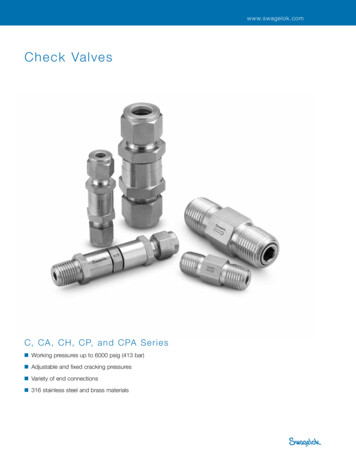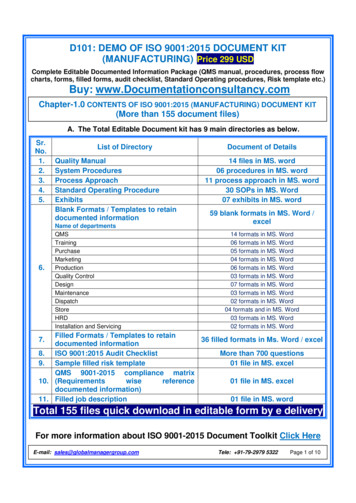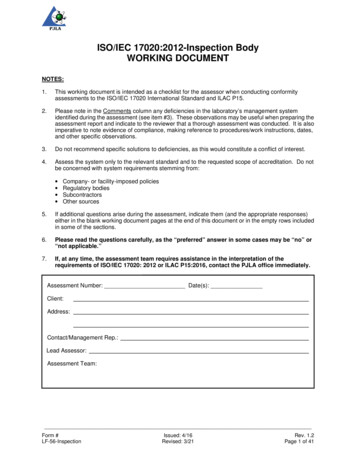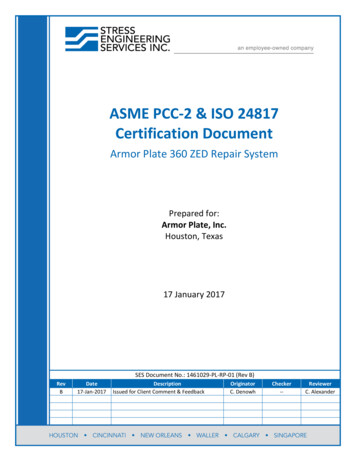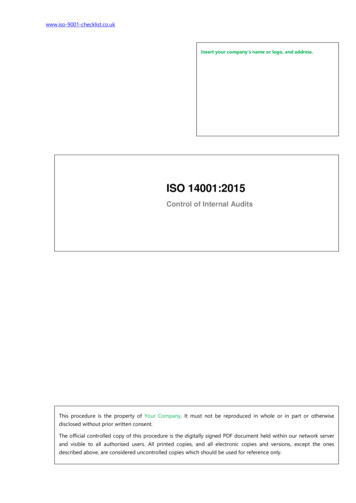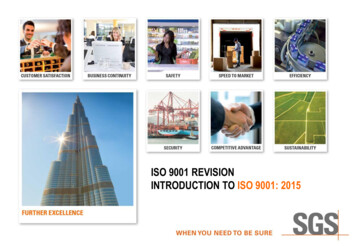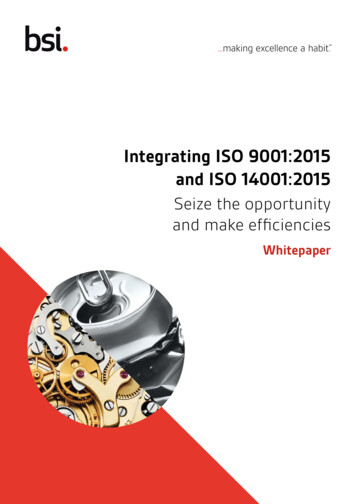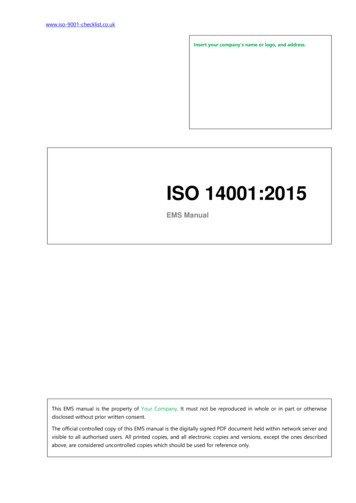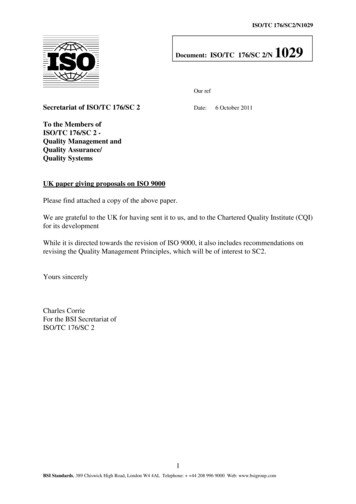
Transcription
ISO/TC 176/SC2/N1029Document: ISO/TC 176/SC 2/N1029Our refSecretariat of ISO/TC 176/SC 2Date:6 October 2011To the Members ofISO/TC 176/SC 2 Quality Management andQuality Assurance/Quality SystemsUK paper giving proposals on ISO 9000Please find attached a copy of the above paper.We are grateful to the UK for having sent it to us, and to the Chartered Quality Institute (CQI)for its developmentWhile it is directed towards the revision of ISO 9000, it also includes recommendations onrevising the Quality Management Principles, which will be of interest to SC2.Yours sincerelyCharles CorrieFor the BSI Secretariat ofISO/TC 176/SC 21BSI Standards, 389 Chiswick High Road, London W4 4AL Telephone: 44 208 996 9000 Web: www.bsigroup.com
ISO/TC 176/SC2/N1029September 2011UK position paper for the revision of ISO 90001. IntroductionThis document has been drawn from a paper by the Chartered Quality Institute (CQI) forsubmission to ISO/TC 176, via the UK's mirror committee QS/1. It is intended as an inputinto any future revision of ISO 9000.The implementation of quality management, as currently reflected in the ISO 9000 family ofstandards, has delivered outstanding results, but given the rapidly changing businessenvironment that organizations face, is it delivering enough ?Is our management thinking as currently expressed in ISO 9000 and the other standards inthe ISO 9000 family still fit for purpose, and still achieving adequate results?To address the changing demands we recommend that the content of ISO 9000 is reviewedand amended to ensure it continues to provide the foundations for the individual standardswithin the ISO 9000 family so that they remain consistent and compatible with each othere.g. through the promotion and application of the concepts, fundamentals and principles,and through the use of common terminology; as such it should also provide managementwith a compelling case for the adoption of quality management.This paper provides a basis for discussion of some of the key issues that such a reviewshould address.2. Fundamental concepts of quality management2.1.1 The concept of organization purposeOrganizations are formed to fulfil a specific purpose and that purpose drives everything anorganization does. For an organization to survive in the long term its purpose needs to beoutwardly looking towards the external environment (2.1.2) in which it operates. No longer isbusiness performance measured solely in terms of economic performance. Organizationsof any type need to take into account ecological and social performance in addition tofinancial performance. In all other organizations economics is a restraint to what theorganization and its managers can do.Profit or surplus is important as a resource, a measure of success and must be sufficient tocover the risks but when perceived as a primary purpose of an organization it encouragesmanagers to look inwardly at financial returns instead of outwardly at the contribution anorganization makes to society which is the ultimate judge of its performance. It is thereforevital that the true purpose of the organization is clearly communicated to all those with whom2
ISO/TC 176/SC2/N1029it is involved. Typically this may involve the development of a long term purpose (e.g. Visionand Mission, policies, and improvement objectives) as well as short term performanceobjectives.2.1.2 The concept of external environmentAn organization is bounded by its external environment and can adapt to that environmentor seek to shape it to survive and achieve its aims. It may deliberately influence but cannotcontrol all parts of that external environment or simply react to changes but must understandtheir influence on itself for the organisation to survive and can choose which parts it workswith and how it responds to change.Note ISO 9004 defines the organization's environment as:3.2organization's environmentcombination of internal and external factors and conditions that can affect theachievement of an organization's objectives and its behaviour towards its interestedparties2.1.3 The concept of a management systemAn organization is a complex and dynamic entity that uses a system of management foraccomplishing its purpose (2.1.1) and delivering its desired outcomes. This managementsystem covers the whole organisation and everything it does. It comprises the structure,processes and resources needed to establish an organization’s policies and objectives andto implement the policies and achieve those objectives.An organization’s capability to deliver desired outcomes depends on its leadership’s abilityto align its mission, vision, values and culture with the strategies, policies, processes andresources it employs to achieve them.Organizations that sustain their capability:a) are adaptive to their external environment;b) continually enhance their capability to change/adapt;c) develop collective as well as individual learning;d) use the results of learning to achieve better results.An organization’s outcomes can be intended or unintended, and anticipating their possibleimpact is an essential element in managing performance. Desired outcomes for all of theorganisation's interested parties are more likely to be achieved if its objectives and prioritiesare consistent with those desired outcomes.Successful performance depends on identifying and managing risks to an organization’scapability to deliver planned outcomes consistently. This system can be examined from theperspective of particular objectives such as financial, quality, social responsibility,environment, health and safety etc. This can result in these different perspectives beinglabelled financial management system, quality management system, environmentalmanagement system etc. In reality these subsystems are parts of the whole system each ofwhich can affect its behaviour or its properties but which cannot operate independently.Although critical components need to be documented for effective communication, everyaspect of the management system can never be fully documented. Any description of asystem is at best a model or a particular perspective of reality and in some respects willalways be wrong but will often be useful.3
ISO/TC 176/SC2/N10292.1.4 The importance of interested partiesOrganizations need to attract, capture and retain the support of those organizations andindividuals they depend upon for their success. These are an organization’s interestedparties and include customers, investors, employees, suppliers and society. Each has adistinct role in influencing the manner in which an organization fulfils its mission so thatmanaging the expectations of these groups of interested parties becomes a critical successfactor in any organization. The organisation has no control or choice over some interestedparties, such as society and its political impacts but does have a choice over who itsemployees, customers and suppliers are and what outcomes are delivered to them.Customers impose the primary demands on the organization's goods and services. Theneeds of the other interested parties place constraints upon an organization’s strategy formeeting those demands.Without customers there is no revenue and without revenue there is no business orcommunity to serve. Customers are therefore the most important interested party but inmeeting their demands, organizations are obligated to operate in such a manner thatsatisfies the legitimate needs and expectations 2 of the other interested parties althoughthey do have a choice as to which customers to work with. Consequently interested partymanagement is a key aspect in defining objectives.2.1.5 The concept of qualityQuality is defined as the "degree to which a set of inherent characteristics fulfilsrequirements". The degree to which interested party expectations are met defines thequality of an organization’s outputs which include e.g. goods and services, dividends,information and employee satisfaction.Quality is perceived in several ways:a) satisfying interested party needs and expectations where the gap is the degree ofsatisfaction regardless of the stipulated requirements;b) conformity with customer requirements where the gap is the degree of conformityregardless of the significance of any nonconformities;c) freedom from deficiencies where the gap is the level of deficiency regardless ofsignificance.There are many reasons for paying attention to quality, including:a) maintaining competitivenessb) maintaining reputation and brand equityc) managing innovationd) minimising waste and reducing internal costse) achieving sustained successConsequently quality needs to be the first priority in any organization. Companies that put‘profits first’ have found themselves losing market position because of the inferior qualityand price competitiveness of their goods and services. When quality is the first priority thereare no boundaries. With every product there is a service e.g. delivery or after sales, and withevery service there is product e.g. information or materials. It would be inequitable to pursuea quality first approach with products and a different approach with services, e.g. puttingquality first in the supply of electricity but not in its generation, putting quality first in thesupply of automobiles but not in their delivery and servicing.4
ISO/TC 176/SC2/N1029It has to be recognised that putting customers first is not the same as putting quality firstbecause organizations can control the quality of its outputs but not its customers.Customers often think short term, don’t know what they need and often don’t care about theimpact of their demands on other interested parties.The quality of an organization’s goods and services is judged by the ability of their inherentcharacteristics to not only satisfy particular customers but also to capture a sustainablemarket.”2.1.6 The concept of quality management2.1.6.1 The purpose of quality managementFor an organization to fulfil its mission (or purpose) and achieve its strategic objectives itsactivities have to be managed towards these objectives if its mission is to be fulfilledeffectively.An organization’s strategic objectives are derived from understanding and prioritising themix of interested party needs relative to its mission and these will include objectives formarketing, innovation, human, financial and physical resources together with financial,social and ecological performance including ethics. Among these objectives has to be theobjective of delivering outputs of a quality that satisfy interested party’s expectations aseconomically as is practical whatever the chosen market, product and associated resources.The purpose of quality management is therefore to provide an organization with thecapability of delivering the required outputs and managing that capability in a way thatproduces the desired outcomes for the interested parties.2.1.6.2 Quality as the priorityOrganizations that have made quality their priority have demonstrated a significantimprovement in the quality of their goods and services and as a result improved their safetyand reliability. This has led over time to a substantial increase in productivity and pricecompetitiveness leading to increase profit and market share. Quality management istherefore of strategic importance in every organization seeking to produce high qualitygoods and services, at low cost and high productivity which benefit society and the ecologythus seeking sustained success. Consequently organizations need to set strategic qualityobjectives that are derived from the needs and expectations of its interested parties anddevelop strategies and structures for achieving those objectives.2.1.6.3 Quality planningFor quality to be the priority of an organization it follows that this needs to be translated intoobjectives and plans for achieving those objectives. This has evolved as the concept ofquality planning where effort is focussed on understanding customer needs, developing andvalidating product features that respond to those needs and developing and validatingprocesses capable of producing those product features.2.1.6.4 Quality controlTo consistently achieve quality it is necessary to apply appropriate control to minimiseuncertainty in the achievement of desired outputs. As variation can be detrimental to anorganization’s performance the concept of quality control has evolved to set standards ofperformance and detect and remove undesirable variation in order to prevent change inaccepted standards. If performance becomes predictable, organizations can plan the futurewith confidence that the plans will be carried out.The detection and removal of variation may be effected:5
ISO/TC 176/SC2/N1029a) before an output is produced by such means that anticipates potential problems andinstitutes techniques that eliminate particular modes of variation through product andprocess design;b) during the production of an output by such means that detects and removes variationas it occurs so that subsequent processing may continue;c) after an output has been produced by such means that rectify problems beforerelease of the output.2.1.6.5 Quality improvementOrganizations not only need to maintain standards of performance but also look for betterways of achieving their objectives and raise standards of performance in order to sustainsuccess as new threats and opportunities emerge in their operating environment.The concept of quality improvement has evolved for improving performance by bettercontrol of quality, by better utilization of resources and better alignment of objectives withthose of the organization’s interested parties.When undertaking improvement, the performance of each variable can be improvedindependently until the slack among them is used up. Then the perceived set of independentvariables changes to a formidable set of interdependent variables. Improvement in onevariable would come only at the expense of the others.Corrective
ISO/TC 176/SC 2 Document: ISO/TC 176/SC 2/N 1029. ISO/TC 176/SC2/N1029 2 September 2011 UK position paper for the revision of ISO 9000 1. Introduction This document has been drawn from a paper by the Chartered Quality Institute (CQI) for submission to ISO/TC 176, via the UK's mirror committee QS/1. It is intended as an input into any future revision of ISO 9000. The implementation of quality .

